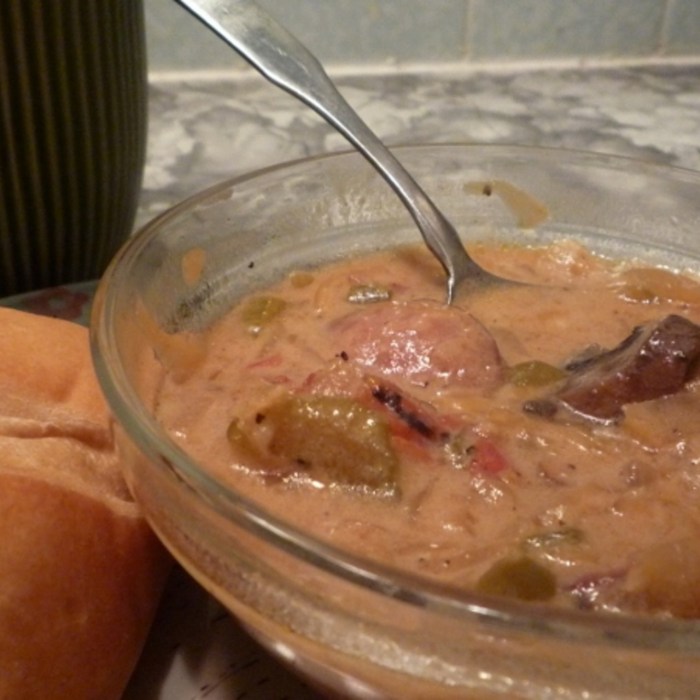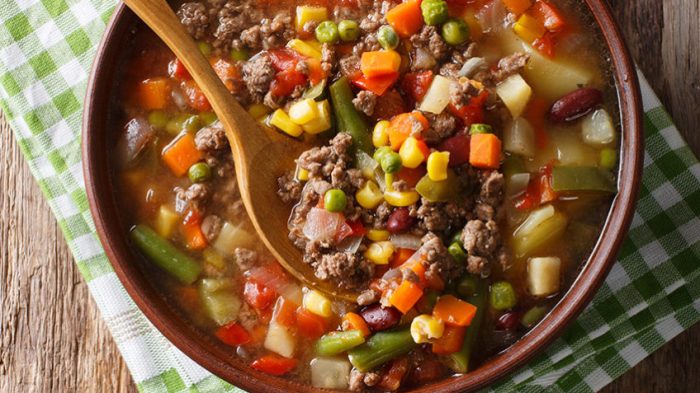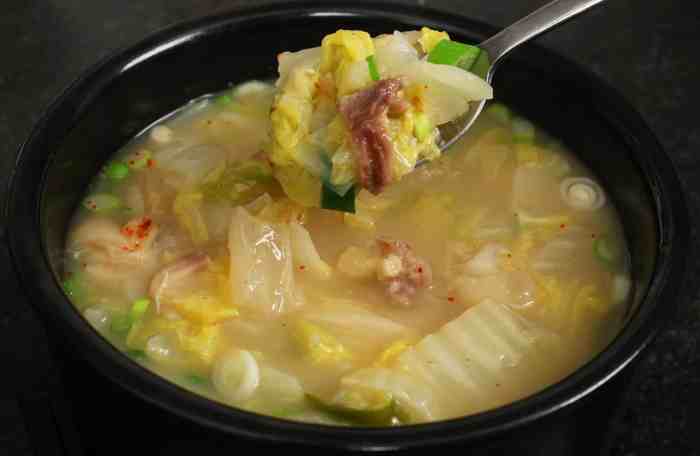Hangover Soup: A Culinary Cure
Recipe hangover soup – The humble hangover soup transcends mere sustenance; it’s a comforting ritual, a culinary balm for a weary soul. This article delves into the history, science, and diverse recipes of this restorative dish, exploring its regional variations and the science behind its effectiveness.
Defining “Hangover Soup”

Source: cloudinary.com
Hangover soup is a broad culinary category encompassing broths and soups designed to alleviate common hangover symptoms. Characterized by its restorative properties, it typically features ingredients rich in electrolytes, vitamins, and minerals often depleted during alcohol consumption. Key ingredients commonly include broth (chicken, beef, or vegetable), easily digestible carbohydrates like rice or noodles, and vegetables such as ginger, garlic, and leafy greens.
Regional variations exist, with ingredients reflecting local culinary traditions and readily available produce.
Historically, hangover soups are rooted in various cultural traditions, often appearing in culinary practices globally as a response to the effects of alcohol consumption. While specific origins are difficult to pinpoint, the underlying concept of using food to ease hangover symptoms is widespread.
Recipe Ingredients and Their Benefits, Recipe hangover soup
The nutritional powerhouses within hangover soup contribute significantly to its effectiveness. Electrolytes, crucial for rehydration, are replenished through ingredients like broth and vegetables. Ginger’s anti-inflammatory properties soothe the stomach, while garlic supports the immune system. The easily digestible carbohydrates provide energy, combating the fatigue often associated with hangovers. Chicken broth, for instance, is rich in protein and amino acids, aiding in recovery.
Different broths offer varying nutritional profiles. Chicken broth provides protein and collagen, while vegetable broth offers a lighter, vegetarian option rich in vitamins and minerals. Beef broth provides a robust flavor and iron content. The choice depends on individual preferences and dietary needs.
Recipe Variations and Customization
Hangover soup recipes are incredibly adaptable. The following three recipes demonstrate variations in spice levels:
- Mild Hangover Soup: Chicken broth, carrots, celery, rice, ginger, and a touch of soy sauce.
- Medium Hangover Soup: Beef broth, potatoes, onions, green chilies, cilantro, and lime juice.
- Spicy Hangover Soup: Vegetable broth, kimchi, gochujang (Korean chili paste), mushrooms, tofu, and scallions.
A vegan/vegetarian option could utilize vegetable broth as a base, incorporating hearty vegetables like lentils, mushrooms, spinach, and a flavorful blend of spices.
| Recipe | Broth | Key Ingredients | Spice Level |
|---|---|---|---|
| Mild | Chicken | Carrots, celery, rice, ginger | Mild |
| Medium | Beef | Potatoes, onions, green chilies, cilantro | Medium |
| Spicy | Vegetable | Kimchi, gochujang, mushrooms, tofu | Spicy |
Adapting for dietary restrictions is straightforward. For gluten-free, use gluten-free noodles or omit them altogether. Dairy-free options easily replace dairy products with alternatives like coconut milk or plant-based creamers.
Preparation and Cooking Methods

Source: club.cooking
A classic hangover soup is simple to prepare. Begin by sautéing aromatics like onions and garlic in a pot. Add your chosen broth, vegetables, and any protein. Simmer until vegetables are tender. Adding noodles or rice towards the end ensures they cook through without becoming mushy.
A hearty hangover soup often incorporates creamy elements to soothe the stomach. For a similarly comforting, yet lighter option, consider adapting elements from a delicious creamed corn soup recipe, such as the one found here: recipe for creamed corn soup. The sweetness and creaminess could easily be incorporated into a hangover soup base, perhaps with the addition of some restorative vegetables and broth for a truly revitalizing meal.
Slow cooking methods enhance flavors. A slow cooker or pressure cooker can be used for optimal results, allowing ingredients to meld beautifully. Proper storage is essential; leftover soup should be refrigerated in airtight containers for up to 3-4 days.
Serving Suggestions and Presentation
Serve hangover soup hot for maximum comfort. Garnishes such as fresh herbs (cilantro, parsley), a squeeze of lime or lemon, and a drizzle of chili oil enhance both flavor and visual appeal. Complementary side dishes include crusty bread for dipping or a simple green salad.
A visually appealing presentation involves serving the soup in a warm bowl, garnished thoughtfully. The vibrant colors of the vegetables, the steam rising from the broth, and the carefully placed garnishes contribute to an overall comforting and inviting presentation.
The Science Behind Hangover Relief
The effectiveness of hangover soup stems from its ability to replenish essential nutrients depleted during alcohol consumption. Alcohol is a diuretic, leading to dehydration. The soup combats this through its high water content and electrolytes. The easily digestible carbohydrates provide energy, and the vitamins and minerals support overall bodily function.
Hydration is key to hangover recovery, and soup contributes significantly to rehydration. Electrolytes like sodium and potassium, often lost through urination, are replenished, aiding in fluid balance. Compared to other remedies, hangover soup offers a holistic approach, addressing multiple aspects of hangover recovery.
Visual Representation of a Recipe

Source: maangchi.com
A finished bowl of hangover soup presents a warm and inviting sight. The broth, depending on the recipe, might be a clear golden yellow (chicken), a rich brown (beef), or a vibrant green (vegetable). The vegetables should be tender yet retain some texture, adding visual interest with their varied colors and shapes. Noodles or rice should be cooked through but not overcooked.
The overall appearance should be comforting and appealing.
During cooking, the visual changes are gradual. Initially, the broth may appear relatively clear, becoming richer in color and depth as the vegetables and other ingredients simmer. The vegetables soften and change in color, often becoming more vibrant or translucent as they cook. The final product showcases a harmonious blend of colors and textures.
Questions and Answers: Recipe Hangover Soup
Can I make hangover soup ahead of time?
Yes, many hangover soups taste even better the next day! Store leftovers in an airtight container in the refrigerator for up to 3 days.
What if I don’t have all the listed ingredients?
Feel free to substitute ingredients based on your preferences and availability. The key is to incorporate hydrating elements and easily digestible foods.
Is hangover soup truly effective?
While not a guaranteed cure, the hydrating and nutrient-rich components of hangover soup can help alleviate some common hangover symptoms. The effectiveness can vary depending on individual factors.
Can I freeze hangover soup?
Yes, you can freeze hangover soup for longer storage. Allow it to thaw completely before reheating.
